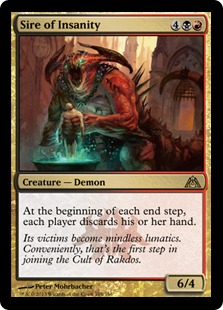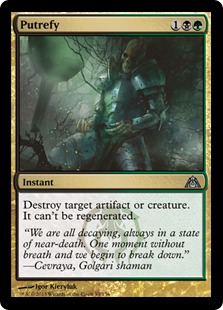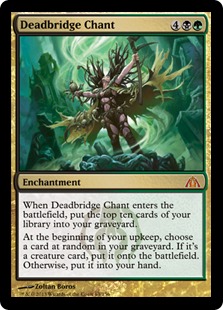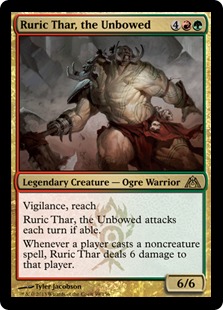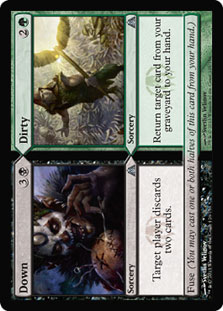This past weekend, I reached the quarterfinals of the Washington, DC World Magic Cup Qualifier with Standard Jund. My continued love for the deck, along with the release of the full Dragon’s Maze spoiler, has me thinking about the potential for Jund in the new Standard format. In my mind, there are a number of appealing possibilities.
Creatures (13)
Planeswalkers (4)
Lands (25)
Spells (18)

From the list I played, the only change I would make is to cut the sideboard Slaughter Games for a sideboard Vampire Nighthawk. I only miss Slaughter Games when I play against a very traditional build of Esper Control, as it really doesn’t have the same impact against other Sphinx’s Revelation decks or even against Reanimator.
The last time I wrote about Jund, I wrote this:
“I don’t claim G/B/W Reanimator is a great matchup, but I don’t consider it something to be scared of either.”
At the time, my experience playing Jund against Reanimator had been good, but I wasn’t willing to pit my own opinion against the certainty of the rest of the MTG community, which had decreed that Reanimator crushed Jund.
Now, a few weeks later, I have the confidence to stand up for my belief that the opposite is in fact true. Jund crushes Reanimator if you build, sideboard, and play the matchup with a solid game plan in mind. I went undefeated against G/B/W Reanimator in the MOCS, Invitational, PTQ, and the Swiss rounds of the WMCQ and have not lost the matchup on Magic Online in recent memory. Of the popular Standard decks, Reanimator was the one I wanted to play against most—by far.
That is until I was paired against Benjamin Glaubinger in the Top 8 of the WMCQ. His build of G/B/W Reanimator posed a particular challenge for me, as he had declined to include any mana creatures and instead relied on the slower but safer Farseek. A crucial aspect of my normal game plan is to keep the Reanimator player’s mana under control by killing their mana creatures, ensuring that they cannot hard cast their giant threats and do not hit the five mana mark before I’m ready for them to do so. I was unable to hold Ben down in this way, and he ended up getting the better of me in a close three-game set.
But this article isn’t for brooding on the past; it’s for looking towards the future! I’m convinced that the future of Jund will hinge on one card from Dragon’s Maze.
Sire of Insanity in Jund
I must admit that Sire of Insanity didn’t really catch my eye the first time I read it over in the spoiler except perhaps as something interesting and flavorful. Upon consideration, though, I feel that Sire of Insanity compares favorably to Rakdos’s Return, which is one of the best and most defining cards of the Jund deck.
I have a tendency, which I believe is common among other players as well, to undervalue the impact of “symmetric effects” on cards. Perhaps it’s my background in math and economics that created this annoying failure of my subconscious. After all, everybody knows that to say
X=3Y
is the same as to say
X-5=3Y-5
(Editor’s Note: Reid has a different definition of “everybody” than I do apparently…)
Now, this is true when X is 6 and Y is 2. It’s not necessarily true when X is Gerry Thompson and Y is Brian Kibler. It’s not necessarily true when X is a Jund player and Y is an Esper player. It’s not necessarily true when player X has more cards in her hand than player Y, or when player Y is mana screwed, or when one of them has a 6/4 Demon in play!
In fact, many of the best cards in Magic are “symmetric effect” cards: Armageddon, Wrath of God, Timetwister, Balance, Smallpox…the list goes on and on. These effects are only symmetric in terms of the wording on the card; in reality the player who builds their deck around Armageddon is liable to be hurt by it much less than the opponent. The player who draws Wrath of God in a game of Sealed Deck has the ability to play the game in such a way that the Wrath of God hurts him much less than the opponent. Alternatively, if he’s winning, he has the option to play the game without casting the Wrath of God. It’s not as if these cards are booby-traps that immediately fire off and ruin everything as soon as they’re drawn off the top of the deck!
So after I’d taken my time to walk through these thought processes in the context of Sire of Insanity, I realized that I’ll rarely need my hand by the time I’m ready to play him. He would be the top of the curve in Jund, and the act of casting a 6/4 creature will typically mean that I’m winning on board. If that’s not the case, then I can just wait one more turn to cast him until I’ve emptied my hand of everything of value.
It would be an oversimplification to say that Sire of Insanity is better than Rakdos’s Return. It would be foolish to disregard the damage that Return deals to a player (or a planeswalker), and it would be foolish to discount the option of casting it for X=3, X=2, or sometimes X=1.
However, if we’re being realistic, Rakdos’s Return is in the deck to be cast for X=4 or more. X=3 is still a powerful effect, but you often need to take that turn to cast a Thragtusk or a Garruk, Primal Hunter. Turn 6 is typically the sweet spot when you’ve somewhat stabilized the board and are ready to nuke everything left in the opponent’s hand. Against control, you now have a card that does that regardless of how many Think Twices they’ve played in the early turns, and against aggro, you have a card that does it while relevantly affecting the board.
Now, I could see a certain future where Standard players come to construct their decks and play their games in such a way that they’re prepared with an instant speed removal spell the turn that Sire of Insanity comes down. However, this will not be the way things are in the early weeks of the new format, and I for one am excited to try out Sire—there will be plenty of time to reconsider afterward.
A not-so-obvious benefit of Sire of Insanity is that he represents a fatty creature that cannot be stolen with Mark of Mutiny (at least the crime cannot be premeditated). He has similar strengths against Supreme Verdict and other sorcery speed removal.
I’ve been considering ways to accelerate Sire of Insanity into play. Mana ramping is fine and good, but you could also consider a card like Heartless Summoning. He has natural synergies with Unburial Rites strategies, as you’ll have plenty of action in your graveyard even when you have no cards in your hand. I’m sure there’s a W/R/B or a W/R/B/G Reanimator deck out there waiting for someone to explore it. However, even if we’re keeping it simple, Sire of Insanity stands apart from Rakdos’s Return in his ability to be cast off Cavern of Souls.
Jund’s Mana Base
In today’s Standard format, the reliability of the mana in a three-color Farseek deck is almost unprecedented. Even with some value lands like Kessig Wolf Run and Cavern of Souls, there’s plenty of room to play around. Consequently, I and the majority of other Jund players have chosen to stretch the mana as far as it will go, playing Garruk, Primal Hunter and Arbor Elf (strict green mana requirements) at the same time as Liliana of the Veil and Victim of Night (strict black mana requirements). It may be worthwhile to change this configuration.
The presence of Sire of Insanity and a handful of other new creatures like Ruric Thar, the Unbowed means that Jund can now get interesting spell-like effects while leaning more heavily on creatures. I believe that the deck will certainly want Cavern of Souls and could even consider a card like Heartless Summoning, which would mean that Rakdos’s Return; Liliana of the Veil; and Garruk, Primal Hunter are needed less and harder to cast.
Murder and Victim of Night can now be replaced by Putrefy, meaning the mana can be skewed away from black. The only constraint that I’ll try not to break is that I still want fourteen or fifteen green lands to cast Farseek on turn 2.
Creatures (14)
Lands (25)
Spells (21)

Note that this is just one of many possible configurations for a new Standard Jund deck. The Heartless Summonings are a bit of a wacky idea that could be either cut out completely or taken to a further extreme. However, it does seem to me like a card that’s poor to draw in multiples and makes sense as a compliment to Farseek as long as the cards you want to ramp into are creatures anyway. The -1/-1 effect is annoying with Huntmaster of the Fells, but in reality it’s not the combat stats of your creatures that you’re really paying for in this deck. At least with Olivia Voldaren, -1/-1 is a wash since you’ll get a free ping right away with the two mana you save.
Putrefy is a strict upgrade to Murder. I’ve already mentioned the biggest upside, which is that it’s easier on the mana. However, insurance against Witchbane Orb, Staff of Nin, and Runechanter’s Pike is certainly nothing to brush off, and with Putrefy the targeted creature cannot regenerate, making it a great answer to something like Lotleth Troll.
Deadbridge Chant is an interesting card, but I view it as similar to (better than) Staff of Nin, which is a card that I’ve been back and forth on as a sideboard option. This type of card is the single best approach to winning the Jund mirror, and the existence of Putrefy now makes Chant substantially better than any artifact that would take the same slot. Deadbridge Chant will have a remarkable ability to win you the game when both players are packing Sire of Insanity!
Ruric Thar, the Unbowed is an excellent card but competes for a slot with Sire of Insanity. It’s also relevantly worse in a deck with Heartless Summoning since one of his inherent strengths is that he can tangle with opposing Thragtusks and Thundermaw Hellkites. Perhaps in a deck less focused on removal and more focused on smashing the opponent’s face in Ruric Thar would get the nod.
I need to give an honorable mention to Down // Dirty, as I very much like the card but don’t think it has a place in this particular list. A one-of Regrowth effect would be welcome in a deck like Jund where the games go long and your cards have unique and powerful effects. However, three mana is a little much, and it can’t be played alongside Ground Seal. Similarly, a Mind Rot is a relevant effect in Constructed, just as it is in Limited, but it doesn’t make much sense to Mind Rot the opponent when you’re planning to stick Sire of Insanity later in the game anyway.
The final card to mention is not one that Jund will be playing with but one that Jund will need to worry about: Blood Baron of Vizkopa. It remains to be seen just how popular this card will be, but the best answer to it is Mizzium Mortars, which is a good card in Jund to begin with. A quick fix is simply to include three or four copies of Mortars in your 75.
Those are my initial thoughts on Jund in Dragon’s Maze Standard. There are many possible configurations to play around with, and a lot of the firm decisions will have to be postponed until we Jund players know exactly what everyone else is going to be up to. However, look towards Sire of Insanity and some upgrades in the removal suite to keep Jund as a top contender!

